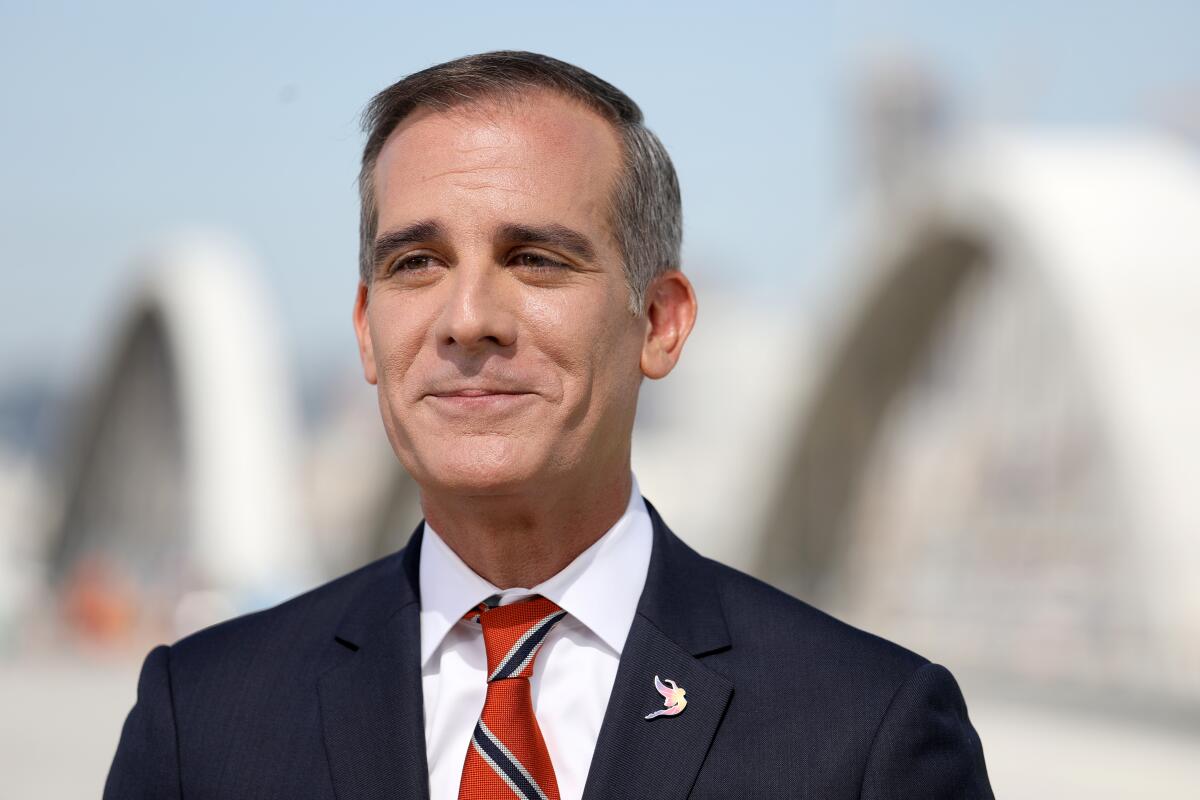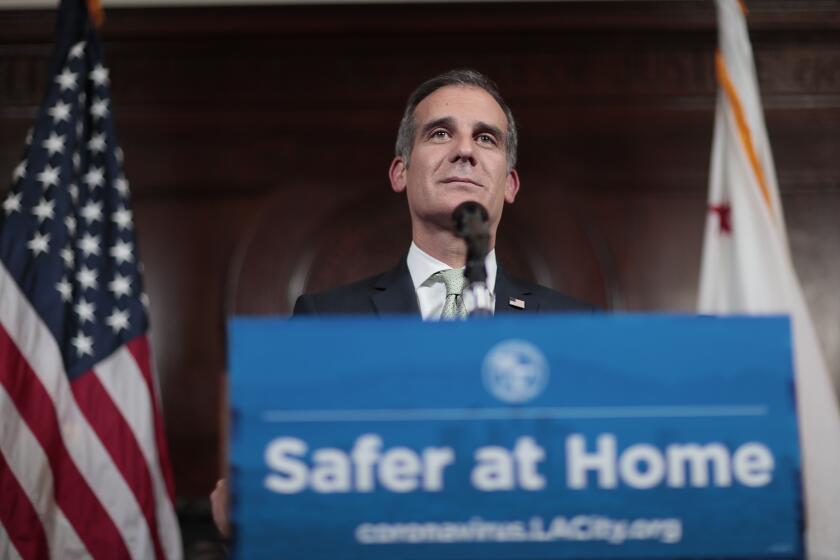Final report on L.A.’s emergency COVID-19 response softens criticism of Garcetti

Several criticisms of Mayor Eric Garcetti and his office were softened or removed from the final version of a report on Los Angeles’ emergency response to the COVID-19 crisis, a Times analysis shows.
The 220-page final report, produced for the city by an outside firm at a cost of $150,000, found that there was never a formal discussion regarding who was in charge of the emergency operation, a misstep that led to a breakdown in coordination and communication among city departments. The earlier draft version of the report reached the same conclusion.
At the same time, both reports offer praise for Garcetti, who “acted quickly and decisively on many fronts, often with innovative initiatives to help protect the city and its people.” City employees’ response was described as “quick” and “heartfelt.”
But the final report removes several criticisms mentioned in the draft, in some cases deleting sentences that were not flattering to the mayor’s office.
Stripped from the final report, for instance, was a reference to how several department leaders who attended Garcetti’s weekly “cabinet” meetings told researchers that the meetings “often felt more like dictations rather than discussions.”
Likewise, a sentence noting that there were complaints from staff at the Emergency Management Department, or EMD, about their work tasks being “politically driven” was removed.
The Emergency Operations Activation After-Action Report was released publicly last week and approved by the city’s Emergency Operations Board. The board forwarded the report to the City Council with no discussion.
A draft report on the city’s emergency response to the pandemic called the operation “uncoordinated and inefficient.”
The city hired CPARS Consulting Inc. to review the city’s emergency response to the COVID-19 pandemic to help prepare for the next catastrophe. Researchers conducted 31 group interview sessions with 153 city staff members and representatives of partner agencies, according to the report.
The Times last year reviewed the non-public draft report, which contained errors, an EMD spokesperson said at the time. Nick Lowe, president and chief executive of CPARS Consulting, said last year that the final version was being completed and that the company “stands by the integrity of each iteration of the report at the time they were drafted.”
The period of the review covered January 2020 to April 2021 and focused only on the city’s emergency management system, which includes the “structures in place to support and enable field operations, programs and service.”
The report did not focus on the city’s vaccination efforts, for instance.
In the final report, “mayor’s office” is dropped or changed in several cases. In one instance, the draft report said that the EMD and its mission were “misunderstood by other departments, particularly the mayor’s office.” The final report said that other “city offices, departments, agencies and bureaus” misunderstood the EMD.
Likewise, the draft report said that “staff from the mayor’s office expressed they viewed EMD as mired by process and bureaucracy, slow to react, and lacking creative solutions.” The final report said simply that “many in senior positions” viewed EMD that way.
In several cases, paragraphs were added to the final report that counter criticisms in the earlier draft.
Both reports note that the EMD said the mayor himself was not as involved as his predecessors in emergency preparedness.
The final version added that “this was not a feeling shared by the mayor’s office which felt the mayor had been sufficiently involved with emergency preparedness considering the other demands of his position and that much had occurred within the mayor’s office.”
“Perhaps limited visibility into the mayor’s emergency preparedness efforts influenced EMD’s perspective,” the final report said.
Lowe, of CPARS Consulting, said little was changed in the final report with regard to the “findings and the substantive analysis.”
He acknowledged the language was softened in parts of the final version, calling the development of such reports a “balancing act.”
“You want the language to be direct and to capture the gravity of the situation and also be strong enough to catch the attention of the right people who are responsible for effecting change,” Lowe said. “We don’t want these reviews to be swept under the rug. At the same time, the findings need to be communicated in such a way that those in positions to effect change will still be receptive to the report’s findings and motivated to take action.”
Get the lowdown on L.A. politics
Sign up for our L.A. City Hall newsletter to get weekly insights, scoops and analysis.
You may occasionally receive promotional content from the Los Angeles Times.
In all, more than 1,300 changes were made to the draft reports, many of them minor edits, according to The Times’ analysis of both drafts.
Lowe said requests for edits were submitted to him by the mayor’s office and other departments and agencies. “CPARS then autonomously adjudicated each request on a case-by-case basis,” he said.
Harrison Wollman, a spokesman for Garcetti, said the mayor made the decision to act decisively at the beginning of the pandemic.
“He chose to make Los Angeles one of the first cities in America to offer free testing, require masking, and stand up mega-vaccination sites,” Wollman said. “Any crisis is an opportunity to take away lessons for the future, and the mayor knows this experience has prepared the city to better handle future emergencies.”
More to Read
Sign up for Essential California
The most important California stories and recommendations in your inbox every morning.
You may occasionally receive promotional content from the Los Angeles Times.












